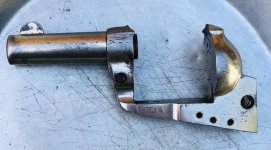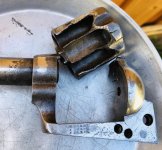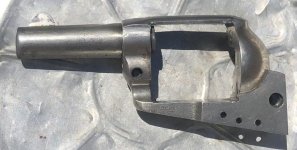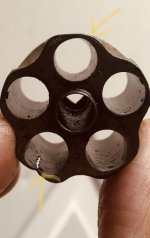. . . Smokeless power will still disassemble a modern Blackpowder revolver. Just clearing up the differences in 19th century steel/iron and 20th century carbon and stainless steels.
Let me start by stating 1880s structural steel could have been produced with around 20,000 PSI tensile strength. Almost all revolvers back then were built to accommodate pressures up to around 15,000 PSI. By 1900 structural steel was over 30,000 PSI. It also must be noted that well established gun factories were using higher strength alloys than building construction materials, so companies like S&W were certainly capable of using steel with tensile strengths well above 20,000 PSI. Unfortunately, there appears to be no information available from the factory detailing late 1800s steel strengths.
50 years of experimenting with smokeless loads in BP era revolvers taught me many things, but most important is that almost all antidotal information posted is from people who never truly researched the subject.
Early in my gun collecting days I had antique Colt 45 SAA revolvers and always adhered to information that I had read about never putting smokeless powder loads in a BP gun or you and your gun will blow up. I recalled the felt recoil was very strong, but not knowing better, I kept loading to original BP specifications. I found no comfort in the articles stating ONLY USE BLACK POWDER IN ANTIQUE GUNS since there was never data or experiences that supported these authors’ opinions!!
Since writers never accompanied their research and findings regarding the use of the dreaded smokeless in BP guns, no research proving the demise of any firearm using smokeless powder noted, just standard message repeated, don't do it. Well, that was worthless information as far as I am concerned without solid reasoning why not!! Sure, there were many failures in the early days of smokeless powder, giving rise to the evils of smokeless powders, but information on how to reload with smokeless left a lot to be desired. People who loaded BP all their lives would load smokeless powder with the same tools, including using the same powder measure that they used for BP loads. Loading smokeless powder, the same volume as BP would guarantee failure since it was likely at least 3X too much powder. To complicate matters further, in the early days there were high-bulk smokeless powders out there that were designed to be loaded by matching the volume to black powder and they worked fine. The danger stories lasted forever and scared many, and are still being perpetuated today.
Back to my 45 Colt revolvers. I had committed the mortal sin by switching to just shooting standard nitro loaded ammo bought at the hardware store. It shot fine and nothing ever happened to me or my guns. The lower recoil made the 45 Colt cartridge much more comfortable to shoot and I kind of forgot about the mule kick offered by BP. As I read more, however, I worried worried that maybe I was tempting fate, so loaded up some old-time cowboy loads with 35 grains of 3F under a 250 grain lead RN. For those of you who have actually shot a full-boat load of BP from the 1800s, you know where I am going with this, but for those of you who preach BP only, try it sometime. It was originally so heavy, 40 grains under a heeled balloon bullet, that Colt backed off the load to 30 grains after too many guns failed the proof testing. Later it was raised back to 35 grains. There were tests done that a 7 ½” gun could run over 1000 fps with the 35 grain load! Pressures would have exceeded 20,000 CUP (roughly the same as PSI at those pressures)!
The recoil was so fierce that I thought the gun would fly out of my hand. After that, I started experimenting and seeking information on chamber pressures for antique handguns and pressures obtained in smokeless loadings. I now can reload just about any antique Colt or S&W caliber out there and can guarantee that there are smokeless loads available with pressures reduced by almost 50% from original BP loadings. Besides, as an added safety measure, I load lighter bullets to further reduce peak pressures. Almost all my S&W caliber loadings average under 10,000 psi. 44 Russian, as one example, can be loaded to less than half the published pressure limit of this caliber and still average over 700 fps with a 200-grain bullet.
Now the next excuse will be that BP exhibits peak pressures in a different portion of the firearm???? Who cares about that anyway? Theory is that the pressure curve is different with BP and that smokeless powder exhibits peak pressure very rapidly compared to BP. First question is why does this matter if the smokeless loads are over 50% lower peak pressure in the first place? In the second place there is research data out there that clearly shows smokeless loadings can be loaded to match BP loads and show almost identical pressure curves. The simple answer is that it is easy to load all BP calibers with smokeless powder and demonstrate a significant reduction in peak pressure out of a revolver and that is a fact. Find your caliber, find your load and give it a try.
Bottom line is that all BP calibers can be loaded with substantially lower pressures than original BP. I still shoot BP in muzzleloaders and Colt Walker reproductions. I shoot those guns with BP for the smoke, plus they are relatively easy to clean up.
45 Colt
IMR Target . . . . 5.0g – 200 RN . . . 802 fps . . . 7,500 PSI
BP . . . . . . . . . . .35g - 250 RN . . . .900 fps . . 16,000 PSI
44 Russian
HP-38 . . . . . . . .4.2g – 200 RN . . . 763 fps . . .7,300 CUP
BP . . . . . . . . . . .20g – 246 RN . . . 750 fps . . 14,500 PSI
The publicly available information above are just a couple examples, but clearly demonstrate one can load and shoot smokeless powder in BP guns with complete, and I can add, increased safety over BP.





